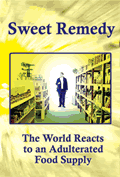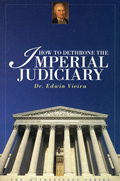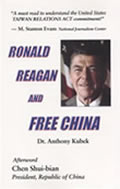FREE ENTERPRISE DID NOT CAUSE THE MARKET MELTDOWN
By
Tom DeWeese
October 28, 2008
NewsWithViews.com
I rarely watch the Sunday morning political shows like Meet the Press and This Week. What's the point? It's just a gabfest of the elite pouring out their version of reality, usually surrounding one lone conservative with a panel of liberals, calling it balanced. I've been in that situation too many times to know real facts rarely get through the posturing.
Yet, for some strange reason I found myself watching several of the shows on the Sunday after the market started its meltdown - just after the Bush Administration proposed its bail out plan. I guess I wanted to hear their reactions to an amazing government proposal to take over the free market.
Most telling was George Stephanopoulos' ABC program, This Week, and his panel of experts, including Sam Donaldson, Donna Brazile and George Will. Again and again the "experts" invoked the 1929 market crash which brought on the Depression. Herbert Hoover's name seemed to be brought up more times than it was in the 1932 election, when Hoover was defeated by Franklin D. Roosevelt.
This team of financial "experts" faced the cameras with serious voices and stern looks as they told America that the bail out was an absolute must or the economy would collapse. And they made sobering comparisons to the 1929 crash, back in the days before government made the market "responsible and reliable." The horrible images of uncontrolled robber barons running amuck were compared to the genius of the Roosevelt reforms and controls that saved the day. We obviously needed more of the same to fix this current mess which, it was implied by the panel, began in the 1980's when Ronald Reagan de-controlled industry.
You know, one really can't blame the panel too much for getting it so wrong. They were just repeating what they had been taught in college. For decades almost all college students have been taught Keynesian economics which advocates an active roll by government in controlling the market and the idea that we can spend our way out of anything. And so, as the mantra goes, Roosevelt stepped in with massive controls and government programs after Hoover did nothing to protect us from big bad business.
According to the economic experts of our day, the bottom line lesson learned from the Great Depression: Laissez-faire free markets are the road to ruin and must be controlled by government for the sake of the people. And the lesson has been learned all over again after that dangerous right-winged radical Ronald Reagan was allowed to once again unleash the money grubbing, heartless princes of greed to bring us all to the brink of collapse, yet again.
Such hogwash. Here's what really happened in 1929 and again today. And it has nothing to do with free markets running amuck. It has everything to do with government messing where it shouldn't be - again.
Cause of the Great Depression of 1929
The Great Depression didn't just happen, and it didn't start in 1929. It started with the creation of the Federal Reserve in 1913. Prior to 1913, private bankers regularly pooled their resources to make money available to other banks and lenders who merited support. Bankers knew that bad loans were an unacceptable risk that could cost them all money, so they didn't do it. They were fiscally responsible. No tax dollars were involved or at risk.
Along came the Federal Reserve and the end to fiscal responsibility. No longer did the private banks have to foot the bill for bad policy. Now it was on the shoulders of government. And so the Federal Reserve proved to be an engine of inflation that crippled our nation's economy. After all, it was just taxpayer money - not the bankers.
Between June, 1921 and June 1929, the nation's money supply increased by 62% (from $45.3 billion to $73.3 billion). Yet as the money supply increased by $28 billion, there was a much smaller increase in bank reserves. The only increase in bank reserves came from the Federal Reserve. In fact, the Federal Reserve controls the money supply by manipulating banking reserves.
The tools the Fed used to manipulate bank reserves in the years prior to the Great Depression were: low rediscount rates, open market purchase of government securities, and extensive purchase of acceptances (credit obligations - loans) - all of which constituted a cheap money policy.
The official reasons for this policy, as provided by the Fed were to "help business," to encourage foreign loans, and to save England from the consequences of its own heavy inflation. First, by easing credit, it was expected that business prosperity could be encouraged and maintained.
Secretary of the Treasury William McAdoo explained the Fed's easy money: "The primary purpose of the Federal Reserve Act was to alter and strengthen our banking system that the enlarged credit resources demanded by the needs of business and agricultural enterprises will come almost automatically into existence and at rates of interest low enough to stimulate, protect and prosper all kinds of legitimate business."
Second, foreign loans would supposedly supply the money which those countries could use to buy American goods, particularly agriculture. American agriculture was already in a deep recession, primarily because of passage of the Forney-McCumber Tariff of 1922. The tariff put a high price on European goods to be sold in the US, essentially preventing the sale. That left the Europeans short of cash and prevented them from buying American goods, especially agriculture. So, instead of reducing the tariff, the government, in its ever-present wisdom, decided to create shaky loans to provide the money to the Europeans to buy U.S. goods. Again, the American taxpayer was providing the money to run the world.
And finally, Great Britain was losing gold to the U.S. at an alarming rate because of its own destructive cheap money policies. So, incredibly, to save the British from embarrassment, the U.S. began a policy to deliberately debase its own currency. By doing so, interest rates would be forced down and capital balances would be diverted from the U.S. to England. Remember, your government is just here to help you.
Dr. Benjamin Anderson, then economist for Chase Manhattan Bank, wrote in his book, Economics and the Public Welfare: "The governors of the eleven Federal Reserve banks were called to Washington (in 1927). They were not dealt with honestly. They were told that the proposed cheap money move was to 'help the farmer'. They were not told that the primary purpose of it was to make it unnecessary for England to honor her gold obligations to France and to make it possible for England to continue an unwarranted degree of cheap money..."
The Chicago Federal Reserve bank didn't want to go along with the scheme and balked, refusing to reduce its (rediscount) rate. But the Federal Reserve Board in Washington overrode Chicago, and by action of the board, not of the bank, the Chicago rate was reduced.
Step by step, by one means or another, in eight years, the Federal Reserve System fed the fires of inflation, increasing the money supply by about 62%. The principle barometer was the stock market. It soared to incredible heights. Whenever it threatened to sag, a timely reassurance from the Secretary of the Treasury helped to send the market even higher. In seven years the market had nearly tripled from 108 to 381.
Finally, the Fed began to realize the danger created from flooding the market with cheap money and shaky loans. It timidly tried to reduce the over-abundant credit supply. It was too late. It was October 1929. The market sought to correct itself.
What caused the Great Depression? It was not capitalism or "greedy businessmen" or "under-consumption" or "overproduction." Nor was it "just one of those things." It was government intervention in a place where government should never be - the free market. And the agony was prolonged for a long, painful decade because government kept doing more of the same to "fix" the tragedy that "uncontrolled, greedy business" had created.
Cause of Today's Meltdown
Shift scene to today. The Fed has never learned its lesson. It has never stopped printing money, resulting in its devaluation. That's why for generations, young people have heard their parents talk about how cheaply they could by a candy bar when they were children, but today they cost much more. That's why gas prices in 1965 were 25 cents a gallon, and $4.00 today. It's not a testimony to greedy candy manufacturers or oil companies. Rather it's an indication of how worthless the dollar has become.
Economics 101 teaches that if you have more of something - it's worth less. If you have less of it, it's worth more. The same is true of the dollar. The Fed has printed literally trillions of the things - and flooded the market with them. As the saying goes, "only the government can take a valuable commodity like paper, slap ink on both sides and render it worthless." That is especially true since President Richard Nixon removed U.S. currency from the gold standard in the early 1970's. Since then, there has been nothing on which to base the value of money other than what the Fed says its worth.
Actually, the current crisis can be directly traced back to the 1970's when a bunch of government meddling was put in place, leading to today's meltdown.
First, in 1977, Jimmy Carter fell for the politically correct line that banks were "redlining" loans for inner city neighborhoods, refusing to help the poor buy homes. Of course the banks were just trying to be fiscally responsible by not lending to people who had no money. Such a quaint idea in 1977. Carter, pandering to the Jesse Jackson types, signed into law the Community Reinvestment Act (CRA), which declared that banks have "an affirmative obligation" to meet the credit needs of the communities in which they are chartered. Federal regulators would now rate banks on this basis when merger requests were filed. The CRA rating became more important to banks than the quality of loans. In fact, sound lending practices were considered to be racist.
In 1995, under Bill Clinton, things got even worse. Tougher CRA ratings were issued. Banks now had to demonstrate that they were investing more money in poor, higher risk neighborhoods if they wanted federal approval to merge. Banks started putting their depositor's dollars into the pockets of left-wing agitators like ACORN, which prided themselves on making loans to those with poor credit and no means to pay. It was only fair that they share in the American dream of homeownership too. The sub-prime borrower was born.
The game was on. The Wall Street Brokerages and investment banks, with the encouragement of federal policy makers, have flooded America with cash. And to get that cash into society, for the common good, lending rules were loosened so that virtually anyone could get a loan, with no money down. It used to be that homebuyers had to have at least a 20% down payment.
But such rules meant that only people with money and the means to pay the loan could get one. Where was the fairness in that? Such an elitist attitude. Prevailing interest rates were also hard for the poor to pay. So that was virtually eliminated too, for at least a few years into the loan. It took less cash to buy a house than to rent an apartment. Buy, buy. Share the American dream. It's "own-a-home a-go-go." Get rich over night. And the stock market soared as the housing industry recorded record profits - or so we thought. It formed a massive bubble - all the way to 14,000 points.
Under the surface, a massive swindle was taking place in the name of profits. Fannie Mae and Freddie Mac were told by their government handlers to record profits. They bought up loans, no matter what quality, to show them on the books. Growth. Success. Incredibly, today, after the government moved in to "fix" the problem at Fannie and Freddie, the new handlers are demanding the same policies - show a profit on the books - which can only result in taking more bad loans.
The AIG Meltdown
Meanwhile, the most credible insurance company in the world, AIG, was making it all seem legitimate. Throughout the world, banks must comply to what are know as Basel II regulations, which determine how much capital a bank must maintain in reserve to protect its depositors. The rules are based on the quality of the bank's loan book. The riskier the loans the bank owns, the more capital it must have on hand. Bank managers seeking away around the Basel rules to take advantage of the massive amounts of new mortgages being written, found a way through AIG.
AIG offered banks unregulated insurance contracts, known as credit default swaps. European banks especially liked these swaps as a means to maximize the spread between what they must pay for deposits and what they could earn by lending. So AIG wrote a policy that guaranteed the sub-prime loan for the bank against default for five years.
As analyst Porter Stansberry reports, "Although AIG's credit default swaps were really insurance contracts, they weren't regulated. That meant AIG didn't have to put up any capital as collateral in its swaps, as long as it maintained a triple-A credit rating. There were no real capital costs to selling these swaps; there was no limit. And thanks to what is called 'make-to-market' accounting, AIG could book the profit from a five year credit default swap as soon as the contract was sold, based on the expected default rate.
Since, throughout history, prior to this insanity, few loans had ever defaulted, the European banks were able to assure its regulators it was holding only Triple A credits, and AIG was able to post hundreds of millions of dollars in profits that only existed on paper, while never having to post any collateral. Says Stansberry, "An enormous amount of capital was created out of thin air and tossed into global real estate markets."
Then the chickens came home to roost. The Fed, trying to reverse the inflation it had caused by flooding the market with worthless paper money, raised the interest rate. The higher rate also raised loan payments on mortgages. Suddenly, the sub-prime borrowers, who had no money in the first place, began to default on the loans. Banks looked to AIG to honor its insurance policies. But AIG had no money to repair the damage. And so, AIG, the world's largest insurance company, was suddenly downgraded by all of the major credit-rating agencies. And AIG went bankrupt.
Such fraud was repeated by Goldman Sacs, Merrill Lynch, Bear Stearns, and more. For sure these are greedy businessmen - but they could never have carried out such bad policy on their own. A free market never allows such corruption to exist without near instant exposure. Once government intervened in the market and set the rules, a partnership between the financial industry and government was born. It was all fueled by the Federal Reserve which continued to pump money into the straining system, putting the dollar in a free fall on world markets. These were worthless loans to satisfy politically correct motives, and worthless money to pay for it all.
|
Subscribe to the NewsWithViews Daily News Alerts! |
Today, the pure free market, buried under this mass of government manipulation, is seeking to correct itself. It will fall until it hits a natural bottom and then begin anew.
The bottom line to the story is it wasn't free enterprise that caused the 1929 crash, and it wasn't free enterprise that caused today's meltdown. In both cases it was government intervention corrupting the pure world of free markets. We are not protected by government intervention - we are damaged by it. This is the second time the Fed created a collapse of the free market. To prevent a third there's only one logical action to take - abolish the Federal Reserve.
� 2008 Tom DeWeese - All Rights Reserved














